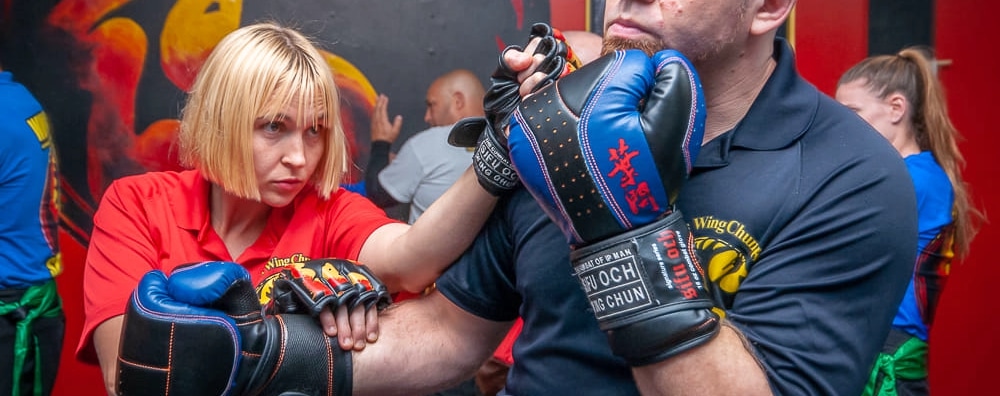Wing Chun Defense Made Simple: A Beginner’s Guide
The first few months of a martial artist are crucial to their success. Instructors must work to instill confidence from day one. The student must learn to trust not only their instructors but also the techniques they are learning. If a student knows what he is learning is practical and useful from the start he will stick around for the fine tuning of those techniques.
At Sifu Och Wing Chun we want to help students learn a basic Wing Chun Defense right from the beginning. To help cover some of the most basic attacks we teach 3 defenses right away: Bui Sao, Tan Sao, and Gan Sao.
Bui Sao
Haymakers (wide hooks) are some of the most common attacks you will see on the street. Without training the body’s natural tendency to draw power will be to twist. This results in a chain and ball effect on the arm with the punch being the ball of course. While these can still do damage they can be easily defended with proper training. That is why one of the first techniques we teach to new students is the Bui Sao. The deflecting hand is shaped as if you were blocking light from the sun. Palm facing away from the body pressing from the elbow. The palm will be about forehead height and the elbow in line with the trachea. This provides a wall of cover with the forearm.


Tan Sao
One of the more famous moves in Wing Chun is the Tan Sao. When teaching it to children we call it the “pizza hand”. This is due to the palm facing upward with the arm extended outward. The Tan Sao is used primarily against straight punches. It deflects punches off the centerline either to the inside or the outside opening up your opponent for a variety of follow ups. You can view a video of the Tan Saos on our Instagram by clicking here>Tan Saos.


Gan sao
Used against nasty body shots or uppercuts is the Gan Sao. Translated it means “low plowing hand”, this technique is very effective for defending the lower half of the body. To shape your Gan Sao simply reach your hand out in front of you as if you were shaking hands with someone. Your hand should end up in front of your belly button and your elbow about a fists distance off of your rib cage. This allows your ribs to be covered and consequently, your hand is now fairly close to your opponents body. You are now prepared for an easily follow up such as a palm to the ribs or an uppercut to the face.


Basic Wing Chun Defense Striking
All three of these defenses have something in common; they are paired with a straight punch. As opposed to many other styles most defenses in Wing Chun are combined with some sort of attack. In this case it is the straight punch. There are other variations off of these basics but for beginners we use the punch to begin with. The straight punch is delivered with the fist held vertically at a 45 degree angle. The reason for this is mainly structure. There is also a nice perk associated with it; it fits nicely under the chin to strike the side of the neck. As a result you can easily deliver a crippling blow to an opponent by simply changing the angle of your fist.
Conclusion
To Summarize, the Bui Sao, Tan Sao, and Gan Sao are three effective and important attacks you must know for your self defense. They allow you attack and defend simultaneously. These are so useful that they were borrowed by many Krav Schools to be incorporated into their system as well. Train these hard and you will have a good starting point.
Related Articles
- Mastering Wing Chun’s Centerline Theory: The Foundation of Effective Defense
https://sifuochwingchun.com/wing-chun-centerline-theory/ - Martial Arts Training: Why Dedicate Quality Time to Wing Chun?
https://sifuochwingchun.com/martial-arts-training-why-dedicate-quality-time-to-wing-chun/ - How to Progress Through the 3 Stages of Martial Arts Training
https://sifuochwingchun.com/the-3-training-cycles-of-martial-arts-tips-for-the-beginner/
We actually address these topics and discuss them in the class, allowing the kids to take part in the conversation with regard to bullying. This lets the subject become less personal, while remaining perfectly applicable to them, making it more of a shared experience and lessening any feelings of pain from past experiences.

Are you ready to start Mastering Wing Chun Defensive Techniques
Take your martial arts skills to the next level? Join Sifu Och Wing Chun Kung Fu today and experience the power of real-world self-defense training. Fill out our contact form and start your Wing Chun journey with the best in Lakeland, Florida!


